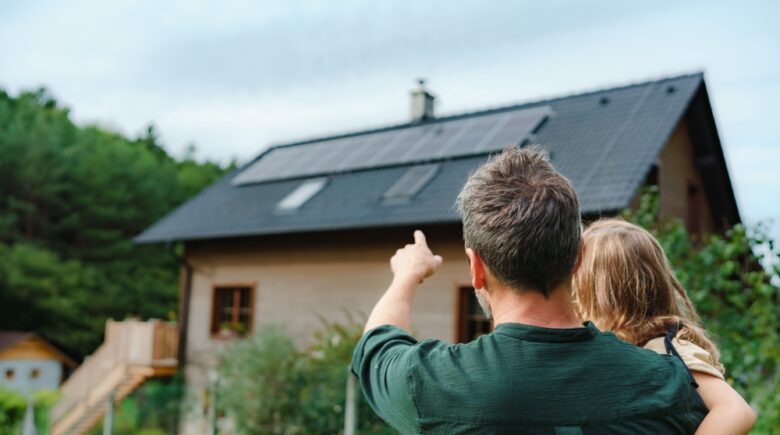Are high energy bills taking a toll on your finances? There’s an alternative that can help lower your costs—renewable energy. If you haven’t already considered using renewable energy at home, it might be time to explore this option.
Not only does renewable energy help protect the environment and fight climate change, but it can also save you money in the long run.
Years ago, the idea of powering your home with renewable energy might have seemed unrealistic. However, advancements in technology have made it increasingly accessible and practical. While it may not be possible to power your entire home with renewable energy, incorporating even one option can significantly reduce your energy costs.
Here are five renewable energy sources to consider:
1. Solar Energy
Solar energy is the most widely used form of renewable energy. Solar panels capture sunlight and convert it into electricity for your home. By installing solar panels, you can cut your electricity costs, especially since any surplus energy can be sent back to the utility grid.
Most solar panels are installed on rooftops, but ground-mounted systems are also available if you prefer. Ground-mounted panels offer flexibility in placement. While solar energy systems can be costly upfront, they’re a smart investment. A typical 5kW system costs between $15,000 and $25,000 and can reduce your electricity bill by up to 75%.
Solar panels are a versatile energy source that can power appliances, charge electric vehicles, and heat your home. Additionally, they work even on cloudy days, making them a reliable option year-round. Although the installation cost can be high, solar panels can increase the value of your home. You can also choose between traditional solar panels or solar shingles, with shingles being easier to install but more expensive.
2. Hydroelectric Energy
If your property is near a flowing water source, like a river or stream, hydroelectric energy could be a viable option. By placing a turbine in the water, you can harness the kinetic energy from the flowing water to generate electricity for your home.
While hydroelectric systems offer a steady and reliable source of energy, they come with environmental and legal challenges. Droughts, for instance, can disrupt energy production. The cost of installation varies depending on the site and materials, making it more suited to rural areas with natural landscapes.
Unlike solar and wind power, hydroelectric energy can provide continuous power as long as water is flowing, offering stability in energy production.
3. Biomass Energy
Although not as well-known, biomass energy is another way to generate renewable energy at home. Biomass energy is produced from organic waste materials, such as wood trimmings, plant waste, or animal waste.
When these materials are burned, they release heat, which can be used to warm your home. A biomass boiler can even generate electricity. Compared to traditional fossil fuels like oil and coal, biomass produces significantly less carbon dioxide, making it a greener option.
4. Geothermal Energy
Geothermal energy uses the stable temperatures found beneath the Earth’s surface to heat and cool your home. A geothermal system consists of underground piping and a heat exchange unit. The pipes contain a liquid that absorbs heat from the ground, which is then transferred to your home. In the summer, the system disperses excess heat back into the Earth.
Installing a geothermal system can reduce your energy bills by up to 72%. The indoor components of these systems can last over 25 years, while the underground piping can last more than 50 years. The installation cost ranges from $20,000 to $30,000, making it an ideal option for homes with large outdoor spaces.
Although geothermal systems require professional installation, they offer long-term savings and environmental benefits by tapping into the Earth’s natural heat.
5. Wind Energy
For homeowners with ample open land, residential wind turbines are an effective way to generate renewable energy. Wind turbines convert the kinetic energy from wind into electricity. The system is connected to a battery, ensuring a steady supply of power, even when wind speeds are low.
Excess energy generated by the turbine can be sent back to the electrical grid. To make wind energy feasible, you’ll need at least one acre of open land with sufficient wind flow, making it a better option for rural areas. A small wind turbine can save you 50% to 90% on your electricity costs annually.
Conclusion
Switching to renewable energy is a great way to benefit both your wallet and the environment. Solar energy is the most popular option, but depending on your location, budget, and available space, you can explore other renewable sources such as wind, hydropower, biomass, or geothermal energy.
No matter which option you choose, renewable energy is an investment that pays off in the long run, helping you reduce costs and contribute to a sustainable future.
Are high energy bills taking a toll on your finances? There’s an alternative that can help lower your costs—renewable energy. If you haven’t already considered using renewable energy at home, it might be time to explore this option.
Not only does renewable energy help protect the environment and fight climate change, but it can also save you money in the long run.
Years ago, the idea of powering your home with renewable energy might have seemed unrealistic. However, advancements in technology have made it increasingly accessible and practical. While it may not be possible to power your entire home with renewable energy, incorporating even one option can significantly reduce your energy costs.
Here are five renewable energy sources to consider:
1. Solar Energy
Solar energy is the most widely used form of renewable energy. Solar panels capture sunlight and convert it into electricity for your home. By installing solar panels, you can cut your electricity costs, especially since any surplus energy can be sent back to the utility grid.
Most solar panels are installed on rooftops, but ground-mounted systems are also available if you prefer. Ground-mounted panels offer flexibility in placement. While solar energy systems can be costly upfront, they’re a smart investment. A typical 5kW system costs between $15,000 and $25,000 and can reduce your electricity bill by up to 75%.
Solar panels are a versatile energy source that can power appliances, charge electric vehicles, and heat your home. Additionally, they work even on cloudy days, making them a reliable option year-round. Although the installation cost can be high, solar panels can increase the value of your home. You can also choose between traditional solar panels or solar shingles, with shingles being easier to install but more expensive.
2. Hydroelectric Energy
If your property is near a flowing water source, like a river or stream, hydroelectric energy could be a viable option. By placing a turbine in the water, you can harness the kinetic energy from the flowing water to generate electricity for your home.
While hydroelectric systems offer a steady and reliable source of energy, they come with environmental and legal challenges. Droughts, for instance, can disrupt energy production. The cost of installation varies depending on the site and materials, making it more suited to rural areas with natural landscapes.
Unlike solar and wind power, hydroelectric energy can provide continuous power as long as water is flowing, offering stability in energy production.
3. Biomass Energy
Although not as well-known, biomass energy is another way to generate renewable energy at home. Biomass energy is produced from organic waste materials, such as wood trimmings, plant waste, or animal waste.
When these materials are burned, they release heat, which can be used to warm your home. A biomass boiler can even generate electricity. Compared to traditional fossil fuels like oil and coal, biomass produces significantly less carbon dioxide, making it a greener option.
4. Geothermal Energy
Geothermal energy uses the stable temperatures found beneath the Earth’s surface to heat and cool your home. A geothermal system consists of underground piping and a heat exchange unit. The pipes contain a liquid that absorbs heat from the ground, which is then transferred to your home. In the summer, the system disperses excess heat back into the Earth.
Installing a geothermal system can reduce your energy bills by up to 72%. The indoor components of these systems can last over 25 years, while the underground piping can last more than 50 years. The installation cost ranges from $20,000 to $30,000, making it an ideal option for homes with large outdoor spaces.
Although geothermal systems require professional installation, they offer long-term savings and environmental benefits by tapping into the Earth’s natural heat.
5. Wind Energy
For homeowners with ample open land, residential wind turbines are an effective way to generate renewable energy. Wind turbines convert the kinetic energy from wind into electricity. The system is connected to a battery, ensuring a steady supply of power, even when wind speeds are low.
Excess energy generated by the turbine can be sent back to the electrical grid. To make wind energy feasible, you’ll need at least one acre of open land with sufficient wind flow, making it a better option for rural areas. A small wind turbine can save you 50% to 90% on your electricity costs annually.
Conclusion
Switching to renewable energy is a great way to benefit both your wallet and the environment. Solar energy is the most popular option, but depending on your location, budget, and available space, you can explore other renewable sources such as wind, hydropower, biomass, or geothermal energy.
No matter which option you choose, renewable energy is an investment that pays off in the long run, helping you reduce costs and contribute to a sustainable future.




